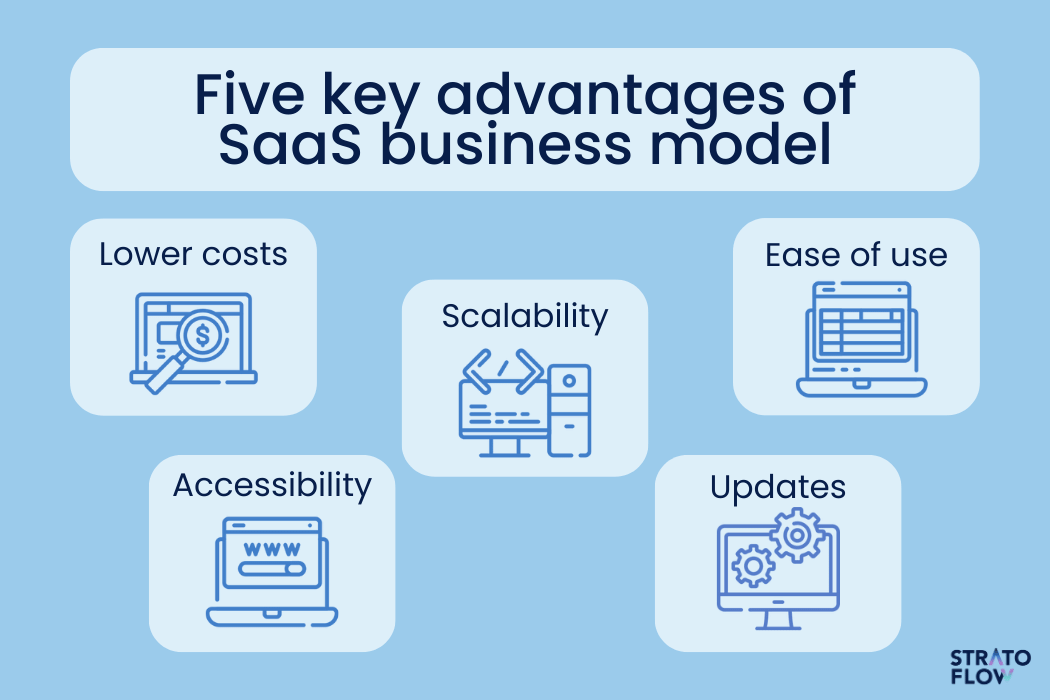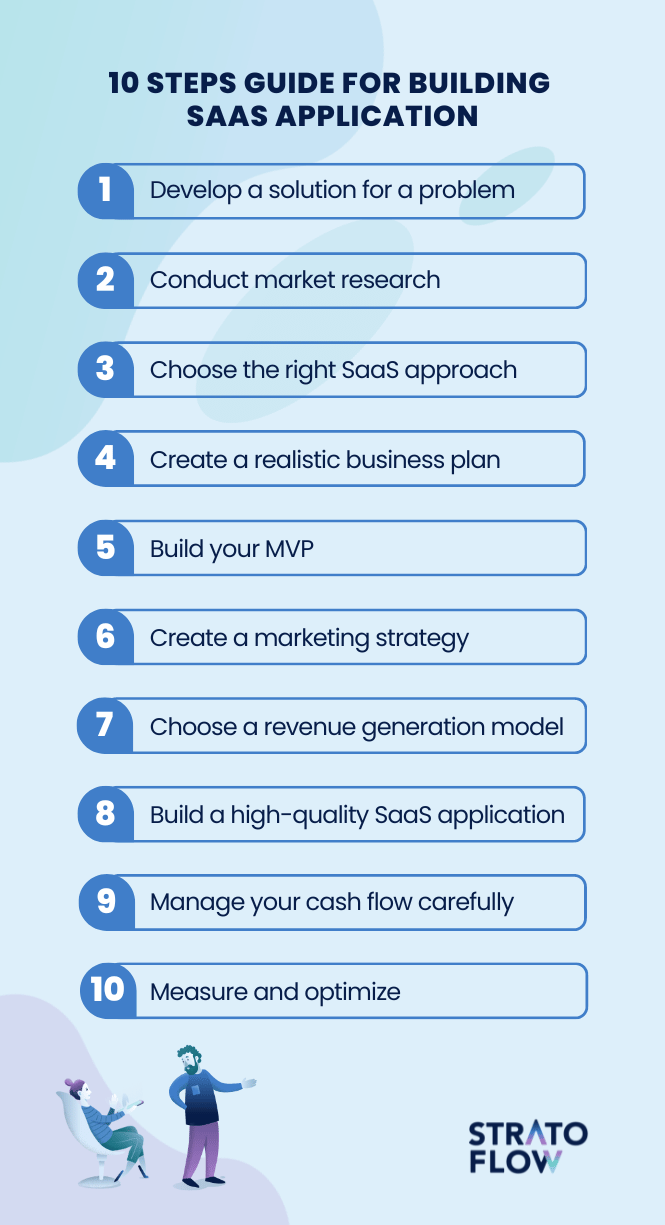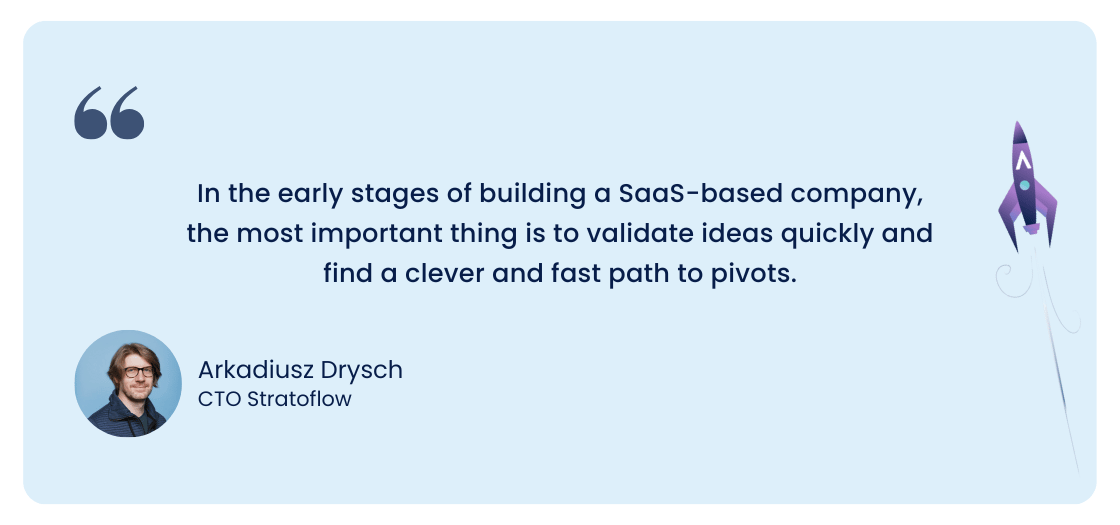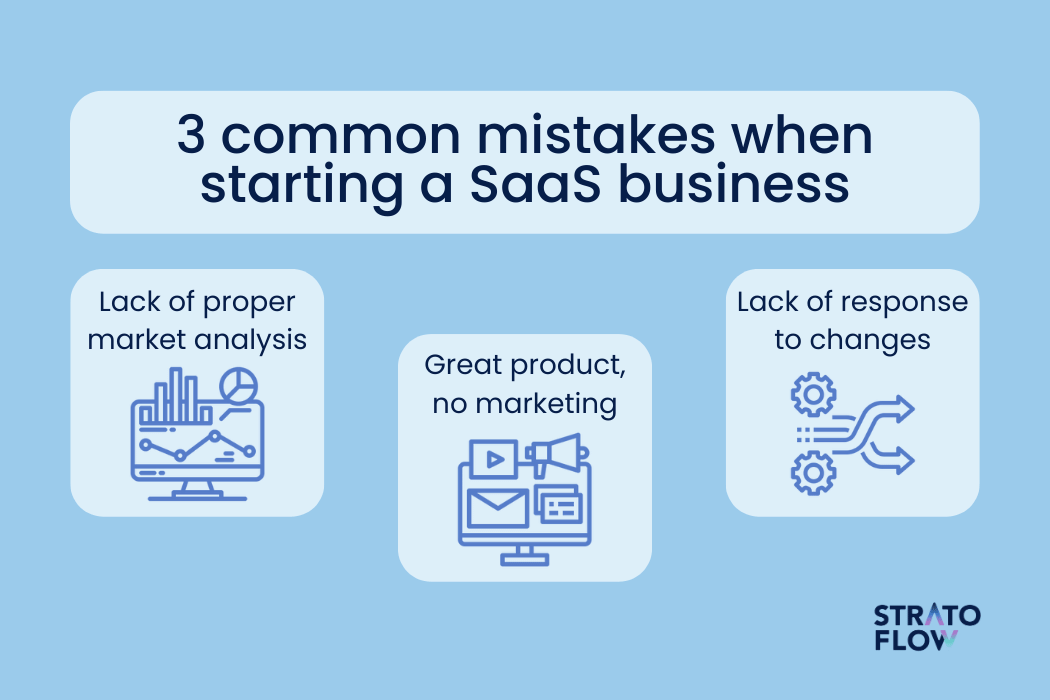
What is SaaS Company and How to Start One?
Thinking about starting your own digital business, but not sure where to start?
The Software as a Service (SaaS) business model has become increasingly popular over the years due to its flexibility, scalability, and cost-effectiveness.
In this article, we will walk you through the essential steps you need to take to launch your own SaaS startup. From identifying your target market to building your product and finding customers, we will cover everything you need to know to get your business off the ground.
So if you’re ready to embark on this exciting journey, let’s get started!
Contents
- What is a SaaS company?
- Types of SaaS companies with examples
- Advantages of SaaS business model
- Risks of SaaS business model
- Is it possible to start a SaaS company without technical expertise?
- Key statistics on SaaS market
- How to start a successful SaaS company in 10 steps
- 3 common mistakes when starting a SaaS company
What is a SaaS company?
SaaS stands for Software as a Service, which is a software delivery model in which software is made available to customers over the Internet, typically on a subscription basis. A SaaS company is a business that specializes in delivering software applications to customers over the Internet.
Instead of customers purchasing and installing software on their own computers or servers, they access the software through a web browser or an application on their device. The SaaS company hosts and maintains the software and is responsible for ensuring its availability and security.
SaaS business model has become increasingly popular for both business applications and personal use.
What is a difference between SaaS company and software company?
SaaS companies and traditional software companies represent different models in the technology and business landscape, each with a unique approach to delivering value to users.
This differentiation is critical to understanding the evolving nature of how software is consumed and paid for.
A traditional software company (like Stratoflow) focuses on developing and selling software products that customers buy, install, and manage on their own computers or servers.
The typical software development process in such companies involves several stages:
- Requirements analysis: Understanding and documenting what the software must do.
- Design: Creating the architecture and how the software will work.
- Implementation: Writing the actual code based on the design.
- Testing: Ensuring that the software works as intended and is free of bugs.
- Deploy: Making the software available for users to install.
- Maintenance: Updating and fixing the software as needed.
This model often involves a one-time purchase price, possibly with additional fees for updates or support. The user is responsible for maintaining and securing the software.
Importantly, upon purchase, users typically agree to a software agreement that outlines how the software can be used, any restrictions, and the responsibilities of both the vendor and the user.
On the other hand, a SaaS company operates under a different model. Usuallt a SaaS company provides software as an online service, hosted in the cloud and accessible through a web browser. Users don’t buy the software outright; they subscribe to use it, typically on a monthly or annual basis (we will talk about a SaaS company pricing model later in this article).
The SaaS company maintains the servers, databases, and code. Moreover, SaaS company is responsible for the ongoing development, security, and maintenance of the software. This process ensures that the software is always up-to-date and meets the evolving needs of its users.
In summary, traditional software companies offer a sense of control and a one-time purchase model, but come with higher upfront costs and responsibility for maintenance. In contrast, a SaaS company offers a more cost-effective, accessible solution with automatic updates and less user responsibility for maintenance, but requires ongoing payments and a reliable Internet connection. The decision between a traditional software company and a SaaS company depends largely on the user’s specific needs, resources, and priorities. As the technology landscape continues to evolve, we may see more hybrid models that combine the best aspects of both traditional software companies and SaaS companies.
Types of SaaS companies with examples
Customer Relationship Management (CRM) SaaS Companies
A CRM SaaS company focuses on delivering software solutions that help businesses manage customer interactions and data throughout the customer lifecycle. These SaaS solutions enhance customer service, drive sales growth, and improve customer relationship management.
Examples: Salesforce, HubSpot.
Project Management SaaS Companies
Project management SaaS companies provide tools to assist teams in planning, executing, and monitoring projects. Project management software solutions include task management, resource allocation, time tracking, and collaboration features, all essential for efficient project management.
Examples: monday.com, ClickUp, Trello, Asana.
Enterprise Resource Planning (ERP) SaaS Companies
These SaaS companies offer comprehensive solutions for business management, integrating processes like finance, HR, manufacturing, supply chain, services, procurement, and others.
Examples: SAP, Oracle.
Financial Management SaaS Companies
These SaaS companies specialize in software solutions for financial operations, including accounting, budgeting, financial planning, and risk management. They cater to businesses seeking cloud-based financial management tools.
Examples: QuickBooks, Xero.
Marketing SaaS Companies
These SaaS companies offer tools for digital marketing, including email marketing, social media marketing, content management, and analytics.
Examples: Mailchimp, Hootsuite, Ahrefs.
Cloud Services SaaS Companies
Operating under the SaaS business model, these companies offer a variety of cloud-based services such as data storage, hosting, and cloud computing. They are vital for businesses needing scalable, accessible, and secure cloud services.
Examples: Google Workspace, Dropbox.
Collaboration and Communication SaaS Software Providers
These SaaS companies provide communication and collaboration tools, enabling teams to work together effectively, whether remotely or in-office. Their solutions typically include chat, video conferencing, file sharing, and real-time collaboration features.
Each type of SaaS company, adhering to the SaaS model, delivers its software solutions over the internet. This approach allows for flexible, scalable, and cost-effective software usage, making SaaS solutions a popular choice across various business sectors.
Examples: Zoom, Atlassian, Slack.
E-Commerce SaaS Companies
SaaS companies offer platforms for building and managing online stores, including website hosting, shopping cart technology, and payment processing.
Examples: Shopify, BigCommerce.
Healthcare SaaS Companies
Focused on the healthcare industry, healthcare SaaS companies provide solutions for patient management, medical billing, telehealth services, and clinical data management.
Examples: Zocdoc, Talkspace.
Education and E-Learning SaaS Companies
These SaaS companies offer platforms for online learning, course management, and educational administration.
Examples: Blackboard, Coursera.
Advantages of SaaS business model
The SaaS business model has become one of the most popular choices for online entrepreneurs in recent years. That’s hardly surprising, as SaaS applications have many advantages that make them a perfect choice in today’s rapidly changing and highly competitive business environment. Let’s take a look at five factors that make the SaaS business model a perfect fit for so many online entrepreneurs.

Lower up-front costs
When launching a new digital product, every company has a choice – go native or go SaaS. But the real question is which of these approaches is more cost-effective.
Both native and SaaS development have different pros and cons. However, from a financial perspective, SaaS web applications tend to be way more cost-effective for companies in the long run. This is because developing a native application can be more expensive due to the need for different code bases for different operating systems. With a SaaS Web application, there is only one core application that can be accessed through a Web browser.
Cost-effectiveness is apparent to SaaS companies, but also to end users as well.
With SaaS model, customers pay a subscription fee to access the software, which is typically less than the cost of purchasing and installing the software on their own servers. This makes it more affordable for businesses of all sizes to access the software tools they need.
Additionally, to ensure a seamless user experience and hassle-free payment processing, a SaaS provider might need, for example, payment gateway integration. This integration enables secure and efficient payment transactions, allowing customers to easily and securely pay their subscription fees, making the adoption of SaaS solutions even more convenient for businesses.
[Read also: How to speed up web application performance?]

Scalability
SaaS solutions are typically designed with scalability in mind, meaning they can be easily expanded as the business grows.
Because SaaS applications are accessed through a web browser, it is much easier for businesses to scale their applications and reach a wider audience. This eliminates the need for companies to create and maintain multiple versions of the software to support different devices or operating systems.
Scalability is also possible from an end-user perspective. SaaS companies typically offer subscription pricing models that allow businesses to pay only for what they need, making it easier for businesses using your SaaS solution to scale up or down as needed. This can be especially important for businesses that experience seasonal fluctuations in demand since they only have to pay when they actually need the software.
Accessibility
Accessibility is arguably the most important benefit of modern SaaS applications. Because you don’t need dedicated software applications, you can access them from any device with an Internet connection, meaning users can use them anywhere, anytime.
This is essentially the killer feature of all SaaS applications. It completely eliminates the need to download and install software on users’ devices. Considering how long and complicated the process of downloading and installing software apps can be, this is extremely important for increasing the popularity of digital products. This is especially true for those SaaS applications that offer limited functionality that users wouldn’t bother with downloading to access.
Ease of use
SaaS applications are designed from the ground up to be user-friendly and intuitive, with simple interfaces and easy-to-use features. This can make them more accessible to users who may not have the technical expertise to use more complex native applications. This, in turn, helps to reduce training and support costs for businesses.
Let’s consider an e-commerce business owner who needs to create some promotional materials for his company. They can either spend a couple of weeks learning the basics of Photoshop, or they can use an off-the-shelf SaaS product that will meet their needs right out of the box. Of course, Adobe Suite software will be far more powerful in the long run, but for these simple use cases, a SaaS application is perfectly fine, especially considering the lack of an installation process and a simple user interface.
That’s why ease of use is an incredibly important aspect of the SaaS business model that appeals to many potential users.
Automatic updates
Last, but not least, there is the issue of updates.
With traditional native software, every time developers want to release a new feature, a new version of the software has to be released and downloaded by all users.
This process is very cumbersome for both users and the development team.
SaaS companies are the opposite. SaaS providers are responsible for maintaining and updating the software, which means that users always have access to the latest features and security updates without having to worry about installing them themselves. The process of updating the software is as simple as pushing the new release to the production environment. All SaaS companies need to do is to promote the new updates through their marketing channels.
Risks of SaaS business model
Is it possible to start a SaaS company without technical expertise?
Starting a SaaS company can be a daunting task. But can you really pull it off if you lack technical expertise?
Well, that depends on how tech-savvy you are. If you have trouble setting up simple Excel spreadsheets or LinkedIn profiles, starting your own SaaS company may not be for you. If you know your way around social media marketing and modern digital services, then you can try to pursue your own SaaS vision with the help of a few digital tools. Let’s take a quick look at the most popular and proven strategies for starting a SaaS company without technical expertise.
No-code and low-code platforms
Low-code and no-code platforms are the answer to one of the biggest problems in the modern SaaS market – high barriers to entry and lengthy development processes.
No-code tools have significantly lowered the barriers to entry in the SaaS market. These platforms provide entrepreneurs with the tools they need to build their simple but efficient SaaS products without writing a single line of code.
Low-code platforms on the other hand are designed to help users build applications using pre-built blocks of code. These blocks can be assembled like building blocks, allowing entrepreneurs to create complex SaaS applications with relative ease. On the other hand, no-code platforms use solely visual interfaces and drag-and-drop tools to let users build applications without coding or any programming knowledge.
While these platforms may seem like a godsend for non-technical entrepreneurs, it’s important to note that technical expertise can still be beneficial, and only experienced software developers can unlock their full potential.

Hiring a technical CTO
While you may not need to have technical expertise yourself, you will need to have a solid understanding of the technology and how it can be used to solve your target customers’ problems.
That’s why some SaaS company owners seek the help of technical CTOs in their organizations.
Their technical expertise and knowledge can help entrepreneurs better communicate with their development team. It will also significantly help business owners in optimizing their product’s performance, developing innovative features, and troubleshooting any issues that may arise. An experienced CTO will be able to provide them with a checklist of aspects of the SaaS application needing the most attention, as well as guide the development process toward a desirable direction.
Outsourcing software development
A third, and probably most convenient for non-technical business executives, option is outsourcing software development to an external custom software development company.
A software company can provide you with a tailored approach with your SaaS product vision as a top priority. They will be responsible for choosing the right tools, tech stack, and technologies for your project and assigning developers with the necessary knowledge and experience, basically eliminating the need for any technical expertise on the part of business owners.
You might assume that this solution will be the priciest one, but in reality, it’s quite the opposite. Thanks to having dedicated teams of programmers and a hands-on approach, a software development company can start working on your idea almost immediately after agreeing on the project’s budget, without having to worry about lengthy recruitment processes and team management.

Key statistics on SaaS market in 2024
As of 2024, the landscape of SaaS companies and their offerings continues to evolve rapidly.
- Growth of SaaS Companies: The Software as a Service market has been experiencing robust growth. By 2024, nearly 99% of businesses are expected to use at least one SaaS software, demonstrating the pervasive influence of SaaS solutions in the corporate world. This growth is driven by the flexibility and scalability that SaaS companies offer, making their services attractive to a broad range of industries.
- Software as a Service Adoption: In recent years, Software as a Service has become a critical component in the business operations of both large and small companies. The average yearly churn rate for SaaS companies falls within 5-7%, suggesting strong retention and satisfaction among their customer base.
- SaaS Software Providers’ Innovation: SaaS software providers continue to innovate, particularly in integrating AI and machine learning technologies into their products. This has led to more sophisticated and efficient SaaS solutions, contributing to the overall growth and adoption of these services.
- Revenue and Market Trends: SaaS solutions have become the largest expenditure for businesses’ cloud services, indicating their significant role in the modern IT landscape. The SaaS market, valued at $186.6 billion in 2022, shows an annual growth rate of 18%, reflecting the sector’s robust health and promising future.
- Challenges for SaaS Companies: Despite the growth, SaaS companies face challenges, including security concerns. With 42% of companies reporting difficulties in securing SaaS apps, providers are continually seeking ways to enhance the security of their solutions.
- Customer Preferences and SaaS Solutions: The trend towards self-service models in SaaS solutions has been gaining momentum. Customers, especially in the B2B sector, show a preference for self-educating about products rather than interacting with salespersons, which SaaS companies are adapting to in their service offerings.
- Global Reach of SaaS Companies: SaaS companies have a significant presence in North America, which is the most advanced market for these services. The European SaaS market is also seeing substantial growth, with predictions of continued expansion until at least 2025.
In 2024, the SaaS industry demonstrates its resilience and capacity for innovation, driven by the diverse needs of its global customer base and the evolving technological landscape. SaaS companies are not only growing but are also adapting to new challenges and opportunities, making Software as a Service an integral part of the modern business toolkit.
Based on: TechReport, FirstPrinciples Growth.
How to start a successful SaaS company in 10 steps
Building a SaaS company is undoubtedly a gargantuan task.
There are hundreds of moving parts, and worst of all, you can’t be 100% sure that your idea will succeed; that’s just the nature of startups. That being said, here are ten key steps every entrepreneur should follow when starting a new Software as a Service business.

Step 1: Develop a solution for a problem
Before any real on a SaaS company work even begins, there has to be an idea for an application.
And we are not talking about any random idea like “Let’s build a new dating app like Tinder!” That kind of thinking won’t get you anywhere.
And why is that? Because there’s already a dating app like that. It’s called Tinder.
Your Software as a Service idea needs to focus on solving a problem that hasn’t already been solved by someone else. The rule is simple – if you’re not solving a problem, you don’t have a business.
There are a few ways around this.
Solve a problem better than other SaaS companies
Let’s face it, in 2024 it’s really hard to come up with an idea that hasn’t been thought of before.
But that’s not really a problem. All you have to do is find a way to solve a particular problem better than anyone else.
If you can provide certain services faster, better, or more efficiently than the competition in a particular industry, that can be a great start for a SaaS company.
Fix a problem you can relate to
The second approach is to base your solution on relatability.
Your SaaS product should solve your problem, not someone else’s. Only by solving a problem you have struggled with yourself will you fully understand and appreciate the true value of the solution. It can be a concrete foundation of the SaaS company’s mission and vision for years to come.
Use your expertise to fix a problem
Only by knowing the ins and outs of certain industries can you find lucrative niches that are brimming with potential new SaaS business opportunities.
Expertise in certain areas can be your greatest asset in starting a SaaS company – use it!
Step 2: Plan out and conduct market research
Now comes the planning phase.
It’s best to start with a compelling customer story. Create a detailed description of how a customer will use your SaaS application.
Pay special attention to the problems that users in your target audience face and how your application will solve them.
You can then write a scenario of your customer using your software, making sure to include all the intricate details, such as individual buttons and links and what they do when clicked.
This exercise will help you clarify your thoughts before you invest in the development process.
Next comes the research phase.
Many technology companies build user personas in the early stages of market research. For many, these personas have become the cornerstone of any strong marketing strategy.
Keep in mind that a usable persona is one that goes beyond the physical description. This makes sense because to be successful, SaaS companies owners must literally walk in their users’ shoes and understand what they are trying to accomplish. Once they understand their world, they can build a compelling story about how they can solve their problems.
After creating a customer persona, conduct extensive market research to gain insight into the needs, and preferences of your potential customers, but perhaps more importantly, the size of your target market
This exercise will help you refine your SaaS product idea and positioning, develop a solution that meets your customers’ business needs, and validate assumptions about profitability.
Initial market research is closely related to developing a marketing strategy – a sixth step on our list. Even though as a SaaS provider, you should thing about marketing later, you need to be sure that there is a demand for such SaaS products as the one you are creating.
Step 3: Choose the right approach for building your SaaS
After coming up with an innovative idea and ensuring that there will be a demand for such a service it’s now time for choosing the path forward of your SaaS company.
There are generally three ways of going around building a SaaS company:
Fully in-house bespoke solution
First and foremost we’ve got the most classical approach – bearing all the difficulties associated with developing software solutions and building SaaS applications in-house.
As you might suspect this choice necessitates technical knowledge on the part of the company’s founders as well as sacrificing some time on expanding the team by hiring experienced software developers and solutions architects.
White-labeling existing SaaS application
An alternative, or even a shortcut of sorts, for owning your own SaaS business can be white-labeling an existing company.
White labeling is a business practice in which a company purchases and rebrands another company’s product or service as its own. In other words, white labeling involves taking a product or service created by one company and switching the names and logos thereby making it appear as if the purchasing company created the product or service itself.
This allows the purchasing company to offer a product or service without having to invest in the development or production of it themselves.
Outsourcing software development services
The third option is relying on a software company and a team of seasoned professionals that is outsourcing the project to a custom software development company.
As we’ve already mentioned in the previous paragraph, partnering up with software companies is a viable option, especially for those lacking technical knowledge and expertise. The software development company will make sure to create a team of developers with abilities and knowledge best suited to your budget and needs. You won’t have to worry about stuff like HR, team management, and salaries.
Your focus could be solely dedicated towards improving and expanding your up-and-coming SaaS company.
Step 4: Create a sound and realistic business plan
In the fourth step, it’s time to write a short and lean business plan.
This shouldn’t be a lengthy, robust document that delves into details of your SaaS company like budgets and precise market projections.
After all, your idea hasn’t been proven viable at this point. This business plan should be a broad outline that will serve as a foundation for future efforts.
Your SaaS business plan should answer the following questions:
- What is your unique value proposition of my SaaS company?
- What market segment (niche) are you trying to reach?
- Who is your competition of your SaaS company?
- Who are your key team members?
- What are your strong and weak suites, opportunities, and threats?
- Do you have all the necessary resources, and knowledge to move forward?
- When do you plan to launch your SaaS company?
- How much will it cost to build an MVP and later transform it into the complete product?
- What future expansion prospects are possible?
Step 5: Build your MVP
Now it’s time for prototyping, and just as engineers create simplified versions of their inventions, software companies do the same when launching minimum viable products.
A minimum viable product (MVP) is a product development strategy that creates a new product or service with the minimum features necessary to satisfy early customers and gather feedback for future product development.
The goal of an MVP is to test the market with a basic version of the product to validate assumptions, gain insight into customer needs, and minimize the risk of investing time and resources in a product that may not be successful.
An MVP typically includes only the core features of your SaaS products needed to deliver value to early adopters, while omitting non-essential features or functionality that can be added in later releases. The goal is to create a functional product with enough value to attract early users and gather feedback that can be used to improve and enhance the product over time.
The importance of MVPs cannot be overstated, as they provide the company with the ability to validate ideas quickly and efficiently. Arkadiusz Drysch, Stratoflow CTO said this:
“In the early stages of building a SaaS company, the most important thing is to validate ideas quickly and find a clever and fast path to pivots.”

The minimum viable product approach is often used by software companies in development projects, but it can be applied to other industries as well.
By releasing a basic version of a product, SaaS companies can gather real-world feedback and insights from customers, refine the product to meet customer needs better, and build a stronger product with a higher chance of success.
Low-code platforms like Openkoda can be very helpful in developing software MVPs.
They allow you to quickly create a minimum viable product with standard functionality, but perhaps most importantly, they allow you to build on that MVP later. Usually, MVPs are throwaway projects because the way they are written makes them not worth developing any further. With Openkoda, the MVP can act as a solid foundation for the real SaaS application without having to worry about technical debt and suboptimal software architecture.
Step 6: Create a creative marketing strategy
No matter how groundbreaking your SaaS idea is, no one will use it if you don’t promote it.
That’s why step six of starting a SaaS company is to create a creative and effective marketing strategy.
Here are a few things to consider:
Think about how to best reach potential customers
Understanding your target audience is critical for creating a successful marketing strategy.
Use customer personas that you’ve created earlier to better visualize points where you can reach your target audience. Depending on the age and interests of your potential clients these points as well as means for reaching them can vary greatly. The key takeaway is that don’t underestimate that step and choose a holistic approach for working on a suitable marketing strategy.
Create a content strategy
Content is the foundation of any creative marketing strategy. After all, how do you convey the message of your SaaS company’s superiority to potential customers?
Creating useful and informative content that speaks to the needs and interests of your audience is essential to attracting and retaining customers. Develop a content marketing plan that includes blog posts, infographics, social media posts, videos, and webinars.
Leverage social media channels
Social media marketing can be a powerful tool for connecting with your audience and promoting your product. Choose the platforms that are most relevant to your audience and create engaging and visually appealing content.
Consider influencer marketing
Partnerships with influencers or thought leaders in your industry can help you reach a wider audience and build credibility for your product.
Measure, iterate, improve
Track and analyze your marketing efforts to see what’s working and what’s not. Use this information to refine the strategy of your Software as a Service and optimize your campaigns for better results.
Step 7: Choose a proper revenue generation model
Okay, so at this point you’ve honed your SaaS product vision and chosen an appropriate promotion strategy. Now it’s time for you to figure out how to monetize your idea.
SaaS companies typically use a subscription-based pricing model, where customers pay a recurring fee to access the software. However, there are several variations of this approach that SaaS vendors can use, as well as other alternative revenue generation models. Let’s take a quick look at five of the most popular:
Monthly or annual subscriptions
This is by far the most common revenue model for SaaS applications, where customers pay a recurring fee to access the software. The fee can be charged monthly, annually, or at other intervals.

Freemium model
In this model of Software as a Service, the basic version of the software is free, but customers pay for premium features or additional functionality. This model can help attract more customers, as they can try the software before committing to a paid subscription. A good examples of that revenue SaaS model can be Canva, HubSpot or Dropbox. Each of these services can be accessed freely but some premium services are hidden behind the paywall.
Pay-per-use
In this model, customers pay for the amount of software they use, typically measured by the number of users, transactions, or other metrics. This SaaS model can be particularly effective for SaaS applications that are used infrequently or by a small number of users. Examples of such SaaS products include Amazon Web Services (AWS), Twilio, OpenAI, and Salesforce.
Tiered pricing model
With this monetization approach, customers can choose from different pricing tiers based on the features or levels of service they need. This can help customers find a pricing plan that fits their budget and usage needs. Examples of SaaS companies that use a tiered pricing SaaS model include Zoom, Shopify, and ScanRepeat.
Affiliate or referral programs
Additionally, SaaS providers can generate revenue by offering affiliate or referral programs, where they pay commissions to customers or partners who refer new customers to the software. Freshbooks, Sendiblue, and Shopify are among SaaS companies doing referral programs.
Step 8: Build a high-quality software application
This step is basically what you first associate with building a SaaS company. It is only the eighth step on our list. It’s actually quite surprising how much work there is to do before you really dive into building the right SaaS application.
But let’s get down to business.
When developing any software product, regardless of the target audience and use case, there are a few key principles that software engineers must follow.
Measure and improve software performance
Whether low latency and software performance are important for a particular software product should be known from the start.
In the case of internal applications for large enterprises, this should not be an issue. For SaaS businesses, however, performance should be an important consideration.
Measuring and improving the software performance of SaaS applications requires a combination of technical expertise, performance analysis tools, and user feedback. By optimizing both the application code and infrastructure, and regularly monitoring and analyzing performance metrics, organizations can ensure that their SaaS applications perform well and meet the needs of their users.
Consider scalability right from the beginning
When you start a SaaS company, there is no guarantee that your idea will succeed.
Regardless, you should always build your product with the possibility of future expansion in mind.
One of the best ways to do this is to incorporate a multi-tenant database approach into your software architecture. A https://stratoflow.com/multi-tenancy-architecture-definition/multi-tenant architecture allows a single instance of software to serve multiple customers. Each tenant shares the same software application, but their data is isolated and completely invisible to other users.
Multi-tenancy makes it easier to scale SaaS applications because resources can be dynamically allocated to meet the needs of each tenant. This means the application can grow and adapt to changing business needs without requiring significant changes to the underlying infrastructure.
[Read also: An introduction to multi-tenancy]
Write high-quality clean code
Writing top-notch, clean code should be good practice for all developers, regardless of their area of expertise.
Software development projects take time and resources. Developers come and go, but the code base stays with the company. It is therefore incredibly important to make the code that is shared by multiple programmers as easy to read and understand as possible.
Many non-technical users may be surprised at the amount of time software developers spend trying to understand someone else’s code. Writing high-quality, clean code can significantly increase the overall speed of development, and the software itself will be less prone to bugs and errors.
Step 9: Manage your cash flow carefully
When running a modern business, especially in the early stages of development, cash flow should be a top priority.
Some people may assume that all online businesses care about is their income. Well, that’s partially true, but in the early stages of building a business, a much more important financial metric is cash flow.
What do we mean by that?
In the startup space, when you’re building a new product, it’s perfectly fine to run a little bit in the red as long as there are enough cash or liquid assets in the company’s accounts. Look at what Tesla did. It lost money for the first 8 years of its existence, but it didn’t fail. Why not? It had enough capital in the bank from various sources to get through all those years of losing money while it expanded its operations and infrastructure. In the case of SaaS companies, the situation can be similar – you may initially lose money as you build your product.
Keep in mind that all strategic decisions regarding the development of your SaaS company should be made on the basis of realistic and sound forecasts and projections. External funding will run out sooner or later. You need to be absolutely certain that your SaaS business will be self-sustaining and profitable from that point on.
Step 10: Measure and optimize
Building a SaaS company is an iterative process.
What does that mean?
You cannot stay in one place. You need to constantly monitor how users perceive your product, look for opportunities for growth, and tweak your business to get the best results.
Integrate with the most popular analytics tools, such as Google Analytics and Google Search Console, and see how
If you stay in one place, sooner or later your product will be overtaken by the competition. Just look at what is happening now with the implementation of AI technology in various SaaS products. Most business leaders see how big a revolution artificial technology can be and are looking for ways to incorporate AI-enabled features into their products.
[Read also: How to Start Real Estate Business]
3 Common mistakes when starting a SaaS company
Starting your own SaaS company is a complex task that requires knowledge and experience in many different areas. Not surprisingly, there are many pitfalls that entrepreneurs can fall into along the way, leading to major difficulties or outright SaaS failure. Let’s look at the three most common mistakes when starting a new SaaS company:

Mistake 1: Lack of proper market analysis
Remember how in the first step of our list we talked about conducting a thorough market analysis?
What would have happened if this step had been neglected?
You could easily be lured into making false assumptions about untapped market demand for certain services. In reality, users may expect something different, or their needs may already be met by products backed by well-established companies with years of experience.
Then you’ll continue to waste valuable resources, time, and energy developing a SaaS product that won’t yield much in the way of commercial success. As your user base stagnates, you may quickly lose your commitment to developing a SaaS application as a whole, even though the results of your efforts could have been completely different with slightly different initial assumptions.
Mistake 2: Great product, no marketing
Often, SaaS entrepreneurs believe that creating a remarkable product will automatically attract users. A simple LinkedIn post and press release will be enough to gain traction online.
In reality, having a great product is not enough. Marketing plays a critical role in attracting potential customers, because if they are unaware of your existence, they are unlikely to sign up and refer others.
Therefore, it is important to develop a well-crafted SaaS marketing plan that includes a strong go-to-market strategy. This strategy should be tailored to your product and target audience and adjusted as needed over time.
Mistake 3: Lack of response to market changes
The SaaS world is incredibly dynamic and unpredictable, with competitors emerging and technologies evolving frequently. In addition, regulatory and policy changes, as well as emerging technology trends, can severely impact your market position.
To succeed in this ever-changing environment, it is critical to be adaptable and constantly reinvent your products and messaging to maintain and grow market share. Starting with a minimum viable product, you can incrementally improve it by incorporating customer feedback and data-driven insights into your SaaS product. Choose a software development approach that allows for modularity and scalability as the application grows. What’s more, you should always be on the lookout for new ways to improve your product to keep pace with the competition.
Starting your own SaaS company – additional resources
Building a successful SaaS company requires not only a brilliant idea and a bit of luck but also quite a lot of prior knowledge. And it’s not only programming skills and technical expertise that come into play. You have to know your way around the competitive, vibrant, and sometimes vicious environment of startups and venture capitals.
Even though in this article we’ve focused mostly on the technical aspects of building a brand new SaaS company your journey shouldn’t stop here. We highly recommend you check out the lecture series from Paul Graham, Sam Altman, and the early YC founders dedicated solely to the ins and outs of starting a new startup company.
Another must-watch for aspiring online entrepreneurs are the lectures of David Heinemeier Hansson, the creator of the Ruby on Rails framework and Partner at 37Signals. In them he gave extremely valuable insider insights into creating a startup company, but perhaps more importantly on how to make it profitable. For everyone who is thinking about starting their own SaaS startup, this 30-minute watch will be invaluable.
Last but not least in our list of resources for every SaaS company owner, we would like to recommend a rather classic entry: “Zero to One: Notes on Start Ups, or How to Build the Future” by Peter Thiel. It is a crisply written, rational, and practical, collection of insights that should be read not just by aspiring entrepreneurs but by anyone seeking a thoughtful alternative to the current pervasive gloom about the prospects for the current tech market.
How to Start a SaaS Company – closing thoughts
Starting a SaaS company is a challenging but rewarding endeavor.
By following the steps outlined in this article, you can increase your chances of success and build a sustainable business that meets the needs of your target audience. Remember to focus on product-market fit, create a solid marketing plan, and continually adapt to changes in the competitive landscape. With dedication and hard work, your SaaS company can thrive in this ever-evolving digital marketplace.
Related Posts
Are you planning to start a SaaS company? Let us know! Thank you for taking the time to read our blog post!
